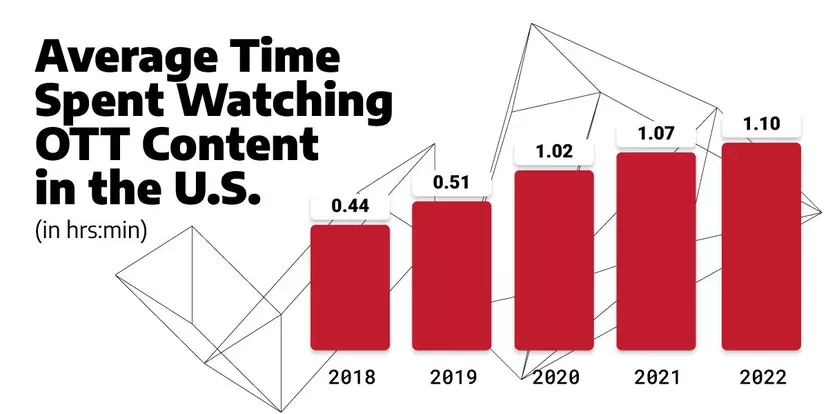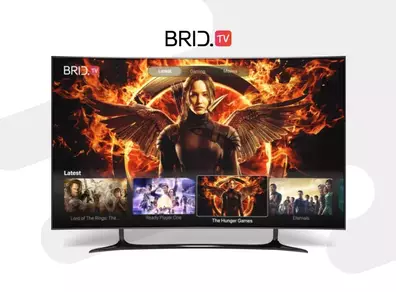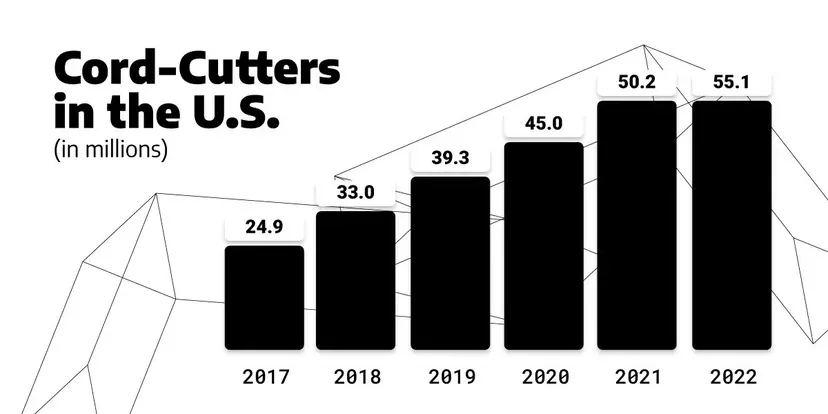Over-the-top technology has been regarded as the future of entertainment for a while now. Statistics estimate that there are over 3.5 billion users of OTT services in 2023 worldwide. More users are moving away from the dying cable television in favor of online broadcasting methods, one of them being over-the-top. But what is OTT anyway and can it truly be the future of entertainment? Let’s find out.
- What Does OTT Mean?
- OTT Terminology: Resolving the Ambiguity
- What Is an OTT Platform?
- How Do OTT Platforms Work?
- Types of Content Suitable for OTT Delivery
- Most Popular Types of OTT Devices
- How Can I Monetize an OTT Channel?
- Benefits of OTT for Video Publishers
- Is OTT Replacing Traditional TV?
- How to Build an OTT Streaming Service to Enter the OTT Market
What Does OTT Mean?
OTT stands for “over-the-top” and entails any streaming media service that distributes content via the internet. It got its name because the content gets delivered through another platform (medium), i.e., “over the top” of another device. In terms of video content, some of the most popular over-the-top platforms include Netflix, Disney+, Paramount+, Hulu, and more.
These platforms are a handy way of bypassing cable or satellite TV providers, who have traditionally controlled content distribution. With over-the-top solutions, however, the user is typically the one who controls what they consume, not the provider.
These solutions proved more practical and flexible than linear TV since people can access most of them through various devices. Besides accessibility from PCs, mobile OTT apps, and tablets, there are also many dedicated devices to choose from. These include gaming consoles, Smart TVs, OTT boxes, and more.
With such high flexibility of OTT TV, it shouldn’t be surprising that the average time spent watching over-the-top video has risen considerably over the last few years.

This sudden growth in popularity just shows how vital control and flexibility are for consumers. Where traditional TV lacked, OTT prevailed.
OTT Terminology: Resolving the Ambiguity
Before we move on to what over-the-top platforms are and how they work, we should clear up any ambiguities surrounding the most commonly used terms in the industry. Here’s a quick overview of the differences between this and other delivery methods like IPTV and CTV.
What Is the Difference Between OTT and Video?
Video and OTT are overlapping terms, but there is a crucial difference in their meanings:
- Video is a type of content users can stream online over TVs, PCs, mobile phones, and even OTT devices.
- OTT is a content distribution method that providers like Netflix use for streaming on various devices.
In other words, the difference between over-the-top and videos is that OTT is a content distribution method for streaming over the internet, while video is a type of content that users may consume using over-the-top streaming.
What Is the Difference Between OTT and CTV?
Many people use these terms interchangeably, and wrongly so. The differences between OTT and CTV are pretty subtle but significant.
Over-the-top is a term for the method that various devices use to deliver video content over the internet. On the other hand, CTV is any television set connected to the internet that viewers can use to watch videos online.
Let’s illustrate that with an example. If you choose to watch your favorite Netflix show on a mobile phone, you’re streaming over the top. But if you decide to watch the same show through the Netflix app on your smart TV, you’re watching CTV.
As you can see, CTV is just one of the many devices people can use to consume this content. Users must install a specific OTT app on their connected TV device to do so.
What Is the Difference Between OTT and IPTV?
IPTV is OTT’s older cousin. The emergence of this technology caused a major shift in how users consume video content in the last two decades. And although these two might seem similar at first glance, there are some fundamental differences between them.
The primary difference between OTT and IPTV lies in how they deliver content. While OTT delivers videos through an open network (internet), IPTV provides them through a closed, controlled ecosystem (LAN, WAN, ISP Networks). That allows IPTV services to serve higher-quality content without relying on internet bandwidth for playback.
However, the above also means that IPTV requires extra hardware to function properly and is significantly more expensive. That makes over-the-top the superior option for most users, despite its lower quality and dependence on internet speed.
The Differences Between OTT and Cable TV
Over-the-top and cable TV are two entirely different worlds. While the former delivers content over the internet, the latter does it through a wired connection. Although cable TV can also be wireless (satellite TV), it has a few other downsides that make it inferior.
The most significant difference is that cable TV mainly provides fixed programming schedules. This forces users to tune in at particular times to catch their favorite shows. Conversely, over-the-top services mostly use the video-on-demand model, allowing users to watch content whenever and wherever they want.
What Is an OTT Platform?
An OTT platform is a content provider that offers live or on-demand video streaming services across various devices and platforms. In this sense, some of the most popular over-the-top platforms include Netflix, Hulu, Disney+, and Amazon Prime.
Unlike traditional broadcasting services, most of these platforms allow users to choose when and what they want to watch. Viewers can often even download entire films or shows at their convenience. With the growing popularity of free ad-supported TV (FAST), some platforms offer experiences similar to traditional TV but without additional expenses and hardware.
However, this term also refers to online video platforms providing white-label OTT solutions to help publishers launch their own services. These platforms, on top of apps, provide video hosting, video library management, and monetization options as a one-stop shop for everything a new or seasoned publisher may need.

How Do OTT Platforms Work?
Between publishers uploading a new piece of content and users requesting to watch it, each video has a long journey ahead. Here’s a general overview of how most OTT platforms work, step-by-step:
- Once the publisher uploads a new video through the platform’s CMS, the video will begin encoding in the cloud.
- After the video is encoded, the end users can request to watch it.
- Once a viewer requests to watch a video, the content will be transcoded into the most suitable video format for their device.
- The DRM software then proceeds to authenticate the end user before finishing preparing the content for delivery.
- If the user’s device successfully passes the authentification, the requested content is handed over to the platform’s CDN and transported over the internet to the user’s device.
- The user receives the content, and the video player starts playback.
Depending on the platform, this process can vary slightly, but it will always follow these general principles.
How Is OTT Content Delivered?
Considering that over-the-top services are available on various devices, handling the delivery process is by no means easy. One of the most significant challenges providers face is adequately adapting to various network performances and display devices. That entails adjusting data streams to multiple network speeds and devices. After all, when watching videos from your phone, you won’t have access to the same internet speeds and bandwidth as on a PC.
That is why these providers must adapt their delivery chains to end-users‘ capabilities. They should be able to deliver content that won’t get interrupted all the time by buffering. OTT providers accomplish that through adaptive bitrate streaming. That means that the provided content’s quality will scale with the end-users’ internet speed and device capabilities. This allows these providers to ensure smooth, uninterrupted playback and optimal user experience.
Types of Content Suitable for OTT Delivery

Although we’ve mostly talked about video content by now, OTT services encompass a much broader spectrum of media. There are multiple types of content suitable for OTT solutions:
Video Content
Video is by far the most common type of OTT media service. When talking about over-the-top, people usually refer to video. But even here, it’s important to mention that there are two types of over-the-top video:
- Video on Demand (VOD) — Most platforms allow users to access pre-recorded videos (VODs) and stream them at will. Most video content on these platforms is of this type.
- Live Video — Some over-the-top platforms will also feature live broadcasts, such as various sports events or even live news. This type of content is rarer, but it’s been gaining prominence as of late.
Audio
The audio market is also competitive, with platforms like Spotify, online radio stations, and podcasts allowing users access to audio libraries. These platforms let users stream audio content the same way platforms like Netflix do video (mobile apps, desktop browsers, etc.).
Messaging
Every internet-based messaging app that works around traditional mobile SMS networks falls under the OTT category. That includes apps like Facebook Messenger, Skype, Viber, WhatsApp, and similar.
VOIP
Voice calling applications and platforms that work via the internet also fall under the definition of OTT. Most of the instant-chat apps include voice calling features too, so they can be classified under this category. Some of the most famous ones are apps like Skype, Viber, and WhatsApp. However, lesser-known VoIP tools, like OpenPhone, often come with more unique features.
Most Popular Types of OTT Devices
As mentioned, one of the major selling points of OTT is that users can access content from whichever device they prefer. Here are some of the most popular types of OTT devices:
Mobile Phones
The mobile video market has grown exponentially over the last few years. Statistics show that more than 90% of all online video streams are viewed from a mobile device. Not being able to reach these users can be detrimental to any publisher. So it should go without saying that mobile devices are one of the first to consider when launching a streaming service.
However, delivering content to mobile phones is challenging, since you’ll need to build an app for the most prominent devices on the market. Luckily, there are solutions out there that can help you out significantly. And no, we’re not talking about building an OTT app from scratch.
Providers such as TargetVideo offer publishers straightforward, white-label OTT app solutions. Whether you’re looking to launch an app for Android, iOS, or another operating system, TargetVideo has got you covered. Get in touch and make a branded OTT app for an array of devices today.

Desktop PCs and Laptops
Despite the rising fame of mobile phones, PCs are still the go-to device for many users. That is why having a website is a must for anyone looking to get into the market. That allows users to easily log into their accounts online and stream videos to their hearts’ content.
Smart TVs
Most modern smart TVs and connected TVs are compatible with some of the best OTT apps on the market, allowing users to enjoy their favorite shows on the big screen. The biggest hurdle for publishers here will be building an app for different TV operating systems. Still, with 65% of viewers consuming content on various mobile and TV apps nowadays, investing in these apps will offer excellent ROI.
Need help launching an OTT app on Samsung and LG smart TVs? TargetVideo’s WebOS and Tizen OTT solutions can help you. Get in touch and start delivering your content to Samsung and LG smart TVs today.
Gaming Consoles
Contrary to popular opinion, gaming consoles aren’t only built for gaming — since they’re connected to the internet, they can also serve as OTT devices. That makes them an incredibly popular solution for consuming over-the-top content among gamers and younger generations. Distributing your app across next-gen consoles like Sony Playstation 5 and Xbox Series X is an excellent way to boost your content’s reach.
How Can I Monetize an OTT Channel?
If you’re just launching (or considering starting) your OTT business, one of the crucial questions you will have to answer is — how do I monetize my OTT service?
There are several different models of OTT monetization you should get acquainted with before you make this decision:
- AVOD — Also known as ad-supported video on demand, AVOD is a video monetization model based on showing promotional content to viewers. In exchange, publishers receive revenue from advertisers for selling them their ad inventory. AVOD is great for publishers who are just starting out and don’t have an established audience, as well as those who don’t offer premium content.
- SVOD — As a subscription-based model, SVOD relies on regular membership payments from users in order to generate revenue. It is one of the most common monetization models used by major publishers, especially in the video world.
- TVOD — With TVOD, publishers rely on individual transactions to generate income. These transactions can cover the cost of an individual viewing (also known as pay-per-view), time-limited access to a piece of content, or time-unlimited (i.e. lifetime) access to a piece of content. This model isn’t too sustainable on its own, but it works great for premium and exclusive pieces of content.
- Hybrid — Of course, publishers can combine two or all three of the above models to create a monetization strategy that works just right for them and their audience.
Benefits of OTT for Video Publishers
As it’s undoubtedly clear by now, choosing over-the-top as your content distribution medium over more traditional methods like cable has plenty of advantages. Here are just a few invaluable benefits OTT brings to any video publisher or streaming provider:
- Audience Reach — Due to the viewers’ ability to choose what, when, and where to watch, OTT is an attractive option for many users around the globe. This wide audience reach will ensure that your content is seen by many.
- Varied Monetization Options — Publishers have a wide range of options when it comes to monetizing their OTT service, including OTT advertising, subscriptions, and more.
- Fast-Growing Market — The number of OTT users is expected to exceed 4 billion by 2027. Rapid market growth means more room for content monetization, with the average revenue per user being over $80.
- Content Control — Unlike posting your content on video-sharing websites such as YouTube, starting your own OTT streaming service gives you full control over content distribution, safety measures, and access restrictions.
You Might Also Like: The State of OTT Marketing: Why Everyone Is Trying It
Is OTT Replacing Traditional TV?
The short answer to this question would be — yes, gradually. The long answer, though, requires some data analysis.
One of the first indicators that OTT is slowly replacing traditional TV is that cord-cutting is more prevalent than ever. In the first half of 2023, traditional media experienced the biggest hit to their market share, with the number of TV subscriptions dropping below 1992 levels in the US.

These numbers are nothing to scoff at, as they represent an exponentially growing trend threatening the TV industry.
Another critical factor to consider is that new OTT services are sprouting all over the place. That is a surefire indicator of the market’s competitiveness since everyone is trying to get a piece of that cake.
Consumer habits are also changing rapidly. More and more users consume content on their phones and other devices nowadays, so the increased accessibility over-the-top platforms provide is what attracts these types of consumers.
So can we say that OTT is replacing traditional TV? In a way, yes. Slowly but surely, OTT is becoming the new norm while TV viewerships are declining. But is TV going to disappear completely? Maybe. We cannot say for sure. Even if it does, one thing is certain — it will still take many more years before that happens. That is, unless the TV industry makes some changes.
How to Build an OTT Streaming Service to Enter the OTT Market
Launching an OTT streaming service from scratch can take a lot of time, money, and technical know-how. That’s why the easiest way to build a video streaming platform is to leverage one of the many OTT platforms that can help you launch, distribute, and monetize an OTT website and app.
Instead of coding everything yourself, you can use the existing technology these platforms provide to publish an app easily, integrate different monetization models, and start your OTT broadcasting business.
If you need a solution to launch an OTT app across various devices, TargetVideo can help you. Publishers can use our Android, iOS, and tvOS SDKs to easily integrate our HTML5 player with their OTT apps across various devices like Roku, Android TV, Apple TV, or Samsung and LG smart TVs.
Our player is equipped with extensive ad support and advanced monetization options like video header bidding and ad podding, alongside other features integral to any OTT service like DRM content protection.
If you wish to launch an ad-supported OTT app with minimal hassle, get in touch with us, and start your OTT journey today.

FAQ
1. What Does OTT Mean?
OTT means over-the-top. The term represents any media streaming service that distributes content over the internet. Examples of OTT streaming services include Netflix, Spotify, Udemy, and more.
2. What Is an OTT Platform?
An OTT platform is a media or content provider that offers live or on-demand streaming services across various devices and platforms. This term can also refer to various online video platforms providing white-label OTT solutions designed to help users build and launch a branded OTT streaming service.
3. What Is an OTT Provider?
An OTT provider allows users to stream live or on-demand video or audio content across the internet. OTT providers like Netflix and Hulu usually offer these services at a monthly subscription fee.
4. What Is OTT Streaming?
OTT streaming entails delivering live or on-demand video or audio content across the internet to various devices (e.g., mobile phones, OTT boxes, gaming consoles). Netflix and Disney+ are some of the most famous OTT streaming services.
5. What Is OTT in Media?
An OTT media service is a streaming service delivered directly over the internet. These services bypass traditional video delivery technologies like cable and satellite and offer greater flexibility to the end user.
6. What Is OTT Video?
OTT video is any video content delivered across to internet to various OTT devices like gaming consoles, mobile phones, or boxes. Users can consume OTT video live or on-demand.
7. What Is an OTT Device?
An OTT device is any device that can receive and stream over-the-top content. These devices include anything from desktop PCs and mobile phones to smart TVs, gaming consoles, and boxes.
8. What Is an OTT App?
An OTT app is an application for streaming live or on-demand video content over the internet. These apps can be available across dozens of devices and operating systems, including various mobile phones and smart TVs.
9. What Is OTT TV?
OTT TV, or over-the-top television, represents all video content streamed on a TV that reaches the end-user over the internet. Users can watch this content while bypassing traditional delivery means like cable or satellite.
10. What Is an OTT Box?
OTT box is a device that uses the internet to deliver video or audio content and broadcast it on your TV. These devices bypass traditional video delivery means like cable or satellite.
